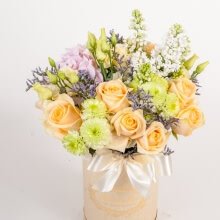Very often, to me, as a person related to growing roses for a cut, my friends and acquaintances ask the same question: how to make the bouquet I bought last longer at home in a vase?
The resistance in a vase is influenced, without exaggeration, by hundreds of factors during the growing process, storage in refrigerators and pre-sale preparation. This, for example, the microclimate in the greenhouse, the number of chemicals used during cultivation, the composition of the nutrient solution in the trade container, the duration of transportation without water, etc., etc. Some of them reduce & laquo; life in a vase & raquo; for several hours, some for several days, but none of these factors are able to create a situation where you brought the bouquet home and two hours later he “hung his head”. «Old Age» roses have nothing to do with it either. Rose "yesterday from the garden" and a rose "two weeks in the fridge" they differ from each other, first of all, by opening time at room temperature, bud color saturation, the presence or absence of stains or "rubbing" on the petals and last but not least.
Moreover, the first should make us happy for 2-3 weeks, and the second 1-2. I declare authoritatively, before a variety goes into industrial production, breeding companies must make a test for "vase life" and, if it is less than two weeks, the variety does not go into production. The only global factor that “multiplies by zero” all efforts of breeders, producers and sellers of roses – it is moisture. Let's try to trace the moisture regimes through which the rose passes from the moment of its birth until the moment it is placed in a vase in your home. So, in the greenhouse is always pre-installed humidity of 75%. This is the ideal humidity for the development and intensive growth of the rose bush. There are many systems responsible for maintaining this parameter, from the heating system to the high-pressure fog. Not all of them cope perfectly with their task, however, the average daily humidity during the entire period of growth and ripening of roses is in the range from 70 to 80%. After the cut, the rose enters the refrigerator. Humidity in the refrigerator ranges from 85 to 92%. Then to the point of sale.
There are plenty of options here: a closed market without heating, a cold store in the flower salon, an underground passage, but in all these places the humidity, except for the summer period, is also relatively high. But in the final, i.e. in your home, a bouquet gets into a room where humidity is rarely higher than 30%, and for many people who like to walk around the house in shorts falls below 15%. This is the most pernicious physiological factor for the continuation of the life of the rose. The stomata of the leaf plate is painfully trying to close in order to reduce evaporation from the surface of the sheet, but cannot fully do this, since they are not “trained” to such a drastic change in the humidity regime. And, as a result, almost instant death.
Believe me, if you, in accordance with the recommendations of Dr. Komarovsky, fill your apartment with air humidifiers and achieve a result in which the humidity of the air does not fall below 60%, then you will have a rose for at least a month, and if it still has access to indirect sunlight, it will take roots in the water and shoot new shoots from the renal sinuses. But, probably, not everyone can comfortably wade through his apartment pushing through clouds of mist produced by humidifiers, or put a bouquet on a glassed-in balcony, where he will be fine, but you will not see it. After all, we are buying flowers in order for them to please us, not to "strain." So what to do to a couple of hours after they gave a bouquet of beautiful roses not to see the tear-stained face of your beloved and not to hear screams of the type: “That's it! I knew you didn't love me anymore, your flowers all wilted !!! " There is one way. It does not work at 100%, such as the battery of humidifiers, but, definitely, will increase the chances of survival to 90-95%.
First, we ask you to wrap the roses in a non-perforated film in the store. Without unpacking the cellophane, at home we cut the stems of roses by 2-3 cm and put the bouquet in a vase 15-20 cm full of water. In any case, we don’t use any "folk" additives like sugar, citric acid, etc. At most, a bag of special products (such as Vaselife), purchased in the same store. Thus, we give the rose time to adapt to new conditions, as a result of blocking the “not breathing” layer of the surface with more leaves.
Secondly, after a day or two, we remove the film and remove the entire leaf from each stem, except for the last 3-4 stalks with leaves at the top of the stem. In this way, we reduce the overall surface of the leaves, from which moisture can evaporate. Water rising along the stem becomes sufficient to maintain the vital activity of the remaining leaves and buds. Do not regret removing more leaves; after placing even in a transparent vase, the appearance of the bouquet as a whole will only improve. We prune, put in fresh water. Water change and pruned every two days. All end, enjoy. If you have already been given a bouquet in paper, a net, etc., go directly to the second item, it will also help.
Vice President of Camellia-PR LLC S. Zagoruiko


